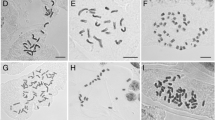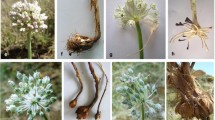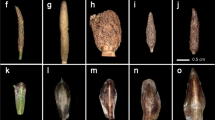Abstract
Five cytotypes have been reported for Jacobaea vulgaris (syn.: Senecio jacobaea); three of them with euploid (tetraploid, hexaploid, and octoploid; 2n = 40, 60, and 80) and one with aneuploid (2n = 32) chromosome numbers. Among them, only tetra- and octoploid cytotypes are regularly found, the other two are very rare. In this study we re-evaluated the origin and systematic position of J. vulgaris octoploids. DNA ploidy levels, morphological, and genetic (AFLP, amplified fragment length polymorphism) data were generated for 38 populations of J. vulgaris from Central and Eastern Europe, and adjacent parts of North-Western Europe. Genetic dataset was supplemented with 16 populations of five closely related species: J. alpina, J. aquatica, J. erratica, J. erucifolia, and J. subalpina. The octoploid cytotype of J. vulgaris, known thus far only from Pannonia and Ukrainian Podillya regions, has also been found on two Baltic islands, Öland and Gotland. AFLP analyses showed clear genetic differences between tetra- and octoploid cytotypes and revealed that all octoploid plants are most likely of autopolyploid origin. The AFLP data also indicate that octoploids form two separate allopatric and monophyletic lineages, one represented by Pannonian and Öland populations, and the other represented by the populations from Podillya and Gotland. The octoploids from Gotland correspond to the previously recognized subspecies J. vulgaris subsp. gotlandica. The octoploids distributed in Pannonia are described here as a new subspecies, J. vulgaris subsp. pannonica.









Similar content being viewed by others
References
Abbott RJ, James JK, Milne RI, Gillies ACM (2003) Plant introductions, hybridization, and gene flow. Philos Trans Ser B 358:1123–1132
Ahlgren H (2011) The origin of the mountain hare on the island of Gotland. Master thesis, Stockholm University
Andersson S (2001a) Fitness consequences of floral variation in Senecio jacobaea (Asteraceae): evidence from a segregating hybrid population and a resource manipulation experiment. Biol J Linn Soc 74:17–24
Andersson S (2001b) The genetic basis of floral variation in Senecio jacobaea (Asteraceae). J Heredity 92:409–414
Bain JF (1991) The biology of Canadian weeds. 96. Senecio jacobaea L. Canad J Pl Sci 71:127–140
Björck S (1995) A review of the history of the Baltic Sea, 13.0–8.0 ka BP. Quaternary Int 27:19–40
Bolkhovskikh ZV, Grif VG, Zakharyeva OI, Matveva TS (1969) Chromosome numbers of flowering plants. Nauka, Leningrad
Bonin A, Bellemain E, Eidesen PB, Pompanon F, Brochmann C, Taberlet P (2004) How to track and assess genotyping errors in population genetic studies. Molec Ecol 13:3261–3273
Clausen J, Keck DD, Hiesey WM (1945) Experimental studies on the nature of species. II. Plant evolution through amphiploidy and autopolyploidy, with examples from the Madiinae. Carnegie Institute of Washington, Washington, DC
Conti F, Bartolucci F, Tomović G, Lakušić D (2012) Jacobaea vulgaris subsp. gotlandica (Compositae), new for Italy and Montenegro. Bot Serbica 36:145–147
Corander J, Marttinen P, Mäntyniemi S (2006) Bayesian identification of stock mixtures from molecular marker data. Fishery Bull 104:550–558
Dobeš Ch, Vitek E (2000) Documented chromosome number checklist of Austrian vascular plants. Verlag des Naturhistorischen Museums Wien, Wien
Doležel J, Doleželová M, Novák FJ (1994) Flow cytometric estimation of nuclear DNA mount in diploid bananas (Musa acuminata and M. balbisiana). Biol Pl 36:351–357
Dufresne F, Stift M, Vergilino R, Mable BK (2014) Recent progress and challenges in population genetics of polyploid organisms: an overview of current state-of-the-art molecular and statistical tools. Molec Ecol 23:40–69
Dumortier BCJ (1827) Florula Belgica. Tournay
Ehrich D (2006) AFLPDAT: a collection of R functions for convenient handling of AFLP data. Molec Ecol Notes 6:603–604
Ekstam U, Jacobson R, Mattson M, Porsne T (1984) Ölands och Gotlands växtvärld. Bokförlaget Natur och Kultur, Stockholm
Excoffier L, Laval G, Schneider S (2005) Arlequin ver. 3.0: an integrated software package for population genetics data analysis. Evol Bioinform Online 1:47–50
Greiner R, Vogt R, Oberprieler C (2013) Evolution of the polyploid north-west Iberian Leucanthemum pluriflorum clan (Compositae, Anthemideae) based on plastid DNA sequence variation and AFLP fingerprinting. Ann Bot (Oxford) 111:1109–1123
Grubbs KC, Small RL, Schilling EE (2009) Evidence for multiple, autoploid origins of agamospermous populations in Eupatorium sessilifolium (Asteraceae). Pl Syst Evol 279:151–161
Grulich V (2005) Senecio L. In: Štěpánková J, Slavík B (eds) Květena České republiky 7. Academia, Praha, pp 250–280
Hedrén M, Fay MF, Chase MW (2001) Amplified fragment length polymorphisms (AFLP) reveal details of polyploid evolution in Dactylorhiza (Orchidaceae). Amer J Bot 88:1868–1880
Hodálová I, Grulich V, Horová L, Marhold K (2007a) Occurrence of tetraploid and octoploid cytotypes in Senecio jacobaea subsp. jacobaea (Asteraceae) in Pannonia and the Carpathians. Bot J Linn Soc 153:231–242
Hodálová I, Vinikarová A, Grulich V, Mereďa P Jr., Horová L (2007b) Reports. In: Marhold K (ed) IAPT/IOPB chromosome data 4. Taxon 56:1269, E1–E3
Hodálová I, Mereďa P Jr, Vinikárová A, Grulich V, Rotreklová O (2010) A new cytotype of Jacobaea vulgaris (Asteraceae): frequency, morphology and origin. Nordic J Bot 28:413–427
Holub J (1972) Senecio × choczensis Holub (S. jacobaeae L. × S. subalpinus Koch)—ein neuer Bastard innerhalb der Gattung Senecio L. Preslia 44:327–333
Huson DH, Bryant D (2006) Application of phylogenetic networks in evolutionary studies. Molec Biol Evol 23:254–267
Jaccard P (1908) Nouvelles recherches sur la distribution florale. Bull Soc Vaud Sci Nat 44:223–270
Kadereit JW, Sell PD (1986) Variation in Senecio jacobaea L. (Asteraceae) in the British Isles. Watsonia 16:21–23
Karlsson T (2001) Adonis L. In: Jonsell B (ed) Flora Nordica 2. The Royal Swedish Academy of Sciences, Stockholm, pp 334–335
Kirk H, Máčel M, Klinkhamer PGL, Vrieling K (2004) Natural hybridization between Senecio jacobaea and Senecio aquaticus: molecular and chemical evidence. Molec Ecol 13:2267–2274
Klecka WR (1980) Discriminant analysis. Sage University papers, Beverly Hills
Kockx-van Roon M, Wieffering JH (1982) Reports. In: Löve Á (ed) IOPB chromosome number reports LXXV. Taxon 31:367
Koutecký P, Štěpánek J, Baďurová T (2012) Differentiation between diploid and tetraploid Centaurea phrygia: mating barriers, morphology and geographic distribution. Preslia 84:1–32
Krzanowski WJ (1990) Principles of multivariate analysis. Clarendon Press, Oxford
Kuzmanović N, Comanescu P, Frajman B, Lazarević M, Paun O, Schönswetter P, Lakušić D (2013) Genetic, cytological and morphological differentiation within the Balkan-Carpathian Sesleria rigida sensu Fl. Eur. (Poaceae): a taxonomically intricate tetraploid-octoploid complex. Taxon 62:458–472
Legendre P, Legendre L (1998) Numerical ecology, 2nd edn. Elsevier, Amsterdam
Leitch IJ, Bennett MD (1997) Polyploidy in angiosperms. Trends Pl Sci 2:470–476
Levin DA (1983) Polyploidy and novelty in flowering plants. Amer Naturalist 121:1–25
Linnaeus C (1753) Species plantarum 2. Holmiae
Löbel S, Dengler J (2007) Dry grassland communities on southern Öland: phytosociology, ecology, and diversity. Acta Phytogeogr Suec 88:13–31
Lowe AJ, Abbott RJ (2004) Reproductive isolation of a new hybrid species, Senecio eboracensis Abbott & Lowe (Asteraceae). Heredity 92:386–395
Macel M, Vrieling K, Klinkhamer PGL (2004) Variation in pyrrolizidine alkaloid patterns of Senecio jacobaea. Phytochemistry 65:865–873
Madlung A (2013) Polyploidy and its effect on evolutionary success: old questions revisited with new tools. Heredity 110:99–104
Májovský J, Murín A, Feráková V, Hindáková M, Schwarzová T, Uhríková A, Váchová M, Záborský J (1987) Karyotaxonomický prehl’ad flóry Slovenska. VEDA, Bratislava
Mandáková T, Münzbergová Z (2008) Morphometric and genetic differentiation of diploid and hexaploid populations of Aster amellus agg. in contact zone. Pl Syst Evol 274:155–170
Marcussen T, Jakobsen KS, Danihelka J, Ballard H, Blaxland K, Brysting AK, Oxelman B (2012) Inferring species networks from gene trees in high-polyploid North American and Hawaiian violets (Viola, Violaceae). Syst Biol 61:107–126
Martin SL, Husband BC (2012) Whole Genome Duplication Affects Evolvability of Flowering Time in an Autotetraploid Plant. PLoS ONE 7:e44784. doi:10.1371/journal.pone.0044784
Mereďa P Jr, Hodálová I, Mártonfi P, Kučera J, Lihová J (2008) Intraspecific variation in Viola suavis in Europe: parallel evolution of white flowered morphotypes. Ann Bot (Oxford) 102:443–462
Meusel H, Jäger EJ (1992) Vergleichende Chorologie der zentraleuropäischen Flora 3. G. Fischer, Jena
Mráz P, Šingliarová B, Urfus T, Krahulec F (2008) Cytogeography of Pilosella officinarum (Compositae): altitudinal and longitudinal differences in ploidy level distribution in the Czech Republic and Slovakia and the general pattern in Europe. Ann Bot (Oxford) 101:59–71
Murín A, Májovsky J (1987) Karyological study of the Slovak flora XIX. Acta Fac Rerum Nat Univ Comenianae Bot 34:3–20
Murín A, Váchová M (1970) Reports. In: Májovský J et al. (eds) Index of chromosome numbers of Slovakian flora (part 1). Acta Fac Rerum Nat Univ Comenianae Bot 16:20
Murín A, Svobodová Z, Májovský J, Feráková V (1999) Chromosome numbers of some species of the Slovak flora. Thaiszia 9:31–40
Nei M, Li WH (1979) Mathematical model for studying genetic variation in terms of restriction endonucleases. Proc Natl Acad Sci USA 76:5269–5273
Neuman LM, Ahlfvengren F (1901) Sveriges Flora. Lund
Nordenstam B (2006) Additions to the genus Jacobaea Mill. (Compositae-Senecioneae). Compositae Newslett 44:12–13
Nordenstam B, Greuter W (2006) Jacobaea Mill. In: Greuter W, von Raab-Straube E (eds) Euro-Med Notulae, 2. Willdenowia 36:707–717
Nordenstam B, Pelser PB, Kadereit JW, Watson LE (2009) Senecioneae. In: Funk VA, Susanna A, Stuessy TF, Bayer RJ (eds) Systematics, evolution, and biogeography of Compositae. IAPT, Vienna, pp 503–525
Otto SP, Whitton J (2000) Polyploid incidence and evolution. Annual Rev Genet 34:401–437
Pelser PB, Gravendeel B, van der Meijden R (2003) Phylogeny reconstruction in the gap between too little and too much divergence: the closest relatives of Senecio jacobaea (Asteraceae) according to DNA sequences and AFLPs. Molec Phylogen Evol 29:613–628
Pelser PB, de Vos H, Theuring HC, Beuerle T, Vrieling K, Hartmann T (2005) Frequent gain and loss of pyrrolizidine alkaloids in the evolution of Senecio section Jacobaea (Asteraceae). Phytochemistry 66:1285–1295
Pelser PB, Veldkamp J-F, van der Meijden R (2006) New combinations in Jacobaea Mill. (Asteraceae–Senecioneae). Compositae Newslett 44:1–11
Pelser PB, Nordenstam B, Kadereit JW, Watson LE (2007) An ITS phylogeny of tribe Senecioneae (Asteraceae) and a new delimitation of Senecio L. Taxon 56:1077–1104
Petit C, Bretagnolle F, Felber F (1999) Evolutionary consequences of diploid-polyploid hybrid zones in wild species. Trends Ecol Evol 14:306–311
Pettersson B (1965) Gotland and Öland. Two limestone islands compared. Acta Phytogeogr Suec 50:131–140
Ramsey J, Ramsey TS (2014) Ecological studies of polyploidy in the 100 years following its discovery. Philos Trans Ser B 369:20130352. doi:10.1098/rstb.2013.0352
Ramsey J, Schemske DW (1998) Pathways, mechanisms, and rates of polyploid formation in flowering plants. Annual Rev Ecol Syst 29:467–501
Richardson BA, Page JT, Bajgain P, Sanderson SC, Udall JA (2012) Deep sequencing of amplicons reveals widespread intraspecific hybridization and multiple origins of polyploidy in big sagebrush (Artemisia tridentata; Asteraceae). Amer J Bot 99:1962–1975
Rieseberg LH (1997) Hybrid origins of plant species. Annual Rev Ecol Syst 28:359–389
Rieseberg LH, Willis JH (2007) Plant speciation. Science 317:910–914
Rieseberg LH, Archer MA, Wayne RK (1999) Transgressive segregation, adaptation, and speciation. Heredity 83:363–372
Rieseberg LH, Raymond O, Rosenthal DM, Lai Z, Livingstone K, Nakazato T, Durphy JL, Schwarzbach AE, Donovan LA, Lexer C (2003) Major ecological transitions in wild sunflowers facilitated by hybridization. Science 301:1211–1216
Rosquist G, Prentice HC (2000) Habitat fragmentation and the structure of genetic diversity within disjunct isolates of Anthericum ramosum L. (Anthericaceae) in Scandinavia. Biol J Linn Soc 69:193–2012
Runyeon H, Prentice HC (1997) Genetic differentiation in the Bladder campions, Silene vulgaris and S. uniflora (Caryophyllaceae), in Sweden. Biol J Linn Soc 61:559–584
Saitou N, Nei M (1987) The neighbor-joining method: a new method for reconstructing phylogenetic trees. Molec Biol Evol 4:406–425
SAS Institute Inc. (2011) SAS ® 9.3 Product documentation. Cary, NC: SAS Institute. http://support.sas.com/documentation/93/index.html. Accessed 1 March 2014
Schlüter PM, Harris SA (2006) Analysis of multilocus fingerprinting data sets containing missing data. Molec Ecol Notes 6:569–572
Schönswetter P, Suda J, Popp M, Weiss-Schneeweiss H, Brochmann C (2007) Circumpolar phylogeography of Juncus biglumis (Juncaceae) inferred from AFLP fingerprints, cpDNA sequences, nuclear DNA content and chromosome numbers. Molec Phylog Evol 42:92–103
Segraves KA, Thompson JN (1999) Plant polyploidy and pollination: floral traits and insect visits to diploid and tetraploid Heuchera grossulariifolia. Evolution 53:1114–1127
Šingliarová B, Hodálová I, Mráz P (2011) Biosystematic study of the diploid-polyploid Pilosella alpicola group with variation in breeding system: patterns and processes. Taxon 60:450–470
Sneath PHA, Sokal RR (1973) Numerical taxonomy. Principles and practice of numerical classification. W.H, Freeman, San Francisco
Soltis DE, Soltis PS (1993) Molecular data and the dynamic nature of polyploidy. Crit Rev Pl Sci 12:243–273
Soltis DE, Soltis PS (1999) Polyploidy: recurrent formation and genome evolution. Trends Ecol Evol 14:348–352
Soltis DE, Soltis PS, Schemske DW, Hancock JF, Thompson JN, Husband BC, Judd WS (2007) Autopolyploidy in angiosperms: have we grossly underestimated the number of species? Taxon 56:13–30
Soltis DE, Albert VA, Leebens-Mack J, Bell CD, Paterson AH, Zheng C, Sankoff D, Depamphilis CW, Wall PK, Soltis PS (2009) Polyploidy and angiosperm diversification. Amer J Bot 96:336–348
Soltis DE, Buggs RJA, Doyle JJ, Soltis PS (2010) What we still don´t know about polyploidy. Taxon 59:1387–1403
Sonnleitner M, Flatscher R, García PE, Rauchová J, Suda J, Schneeweiss GM, Hülber K, Schönswetter P (2010) Distribution and habitat segregation on different spatial scales among diploid, tetraploid and hexaploid cytotypes of Senecio carniolicus (Asteraceae) in the Eastern Alps. Ann Bot (Oxford) 106:967–977
Španiel S, Marhold K, Hodálová I, Lihová J (2008) Diploid and tetraploid cytotypes of Centaurea stoebe (Asteraceae) in Central Europe: morphological differentiation and cytotype distribution patterns. Fol Geobot 43:131–158
Španiel S, Marhold K, Filová B, Zozomová-Lihová J (2011) Genetic and morphological variation in the diploid-polypoid Alyssum montanum in Central Europe: taxonomic and evolutionary considerations. Pl Syst Evol 294:1–25
Stebbins GL (1971) Chromosomal evolution in higher plants. Addison-Wesley Publishing Company, Reading, Massachusetts
Sterner R, Lundqvist Å (1986) Ölands kärlväxtflora, 2nd edn. Lund, Svensk botanisk tidskrift, Forskningsrådens förlagstjänst, Stockholm
Thompson JN, Nuismer SL, Merg K (2004) Plant polyploidy and the evolutionary ecology of plant/animal interactions. Biol J Linn Soc 82:503–510
Tukey JW (1977) Exploratory data analysis. Addison-Wesley Publishing Company, Reading, Massachusetts
van den Brand C, van Meel FCM, Wieffering JH (1979) [Report]. In: Löve Á (ed) IOPB chromosome number reports LXIV. Taxon 28:397
Vanneste K, Maere S, Van de Peer Y (2014) Tangled up in two: a burst of genome duplications at the end of the Cretaceous and the consequences for plant evolution. Philos Trans Ser B 369:20130353. doi:10.1098/rstb.2013.0353
Vinikarová A (2009) Octoploid Senecio jacobaea versus S. erucifolius in South Moravia. Zprávy Čes Bot Společn 44:29–34
Vos P, Hogers R, Bleeker M, Reijans M, van de Lee T, Hornes M, Frijeters A, Pot J, Peleman J, Kuiper M, Zabeau M (1995) AFLP: a new technique for DNA fingerprinting. Nucl Acids Res 23:4407–4414
Wysk R, Nordenstam B, Kadereit JW, Westberg E (2009) The identity and geographical distribution of Jacobaea vulgaris subsp. gotlandica, supposedly endemic to Gotland and Öland (Sweden)–the importance of multiple intraspecific samples. Taxon 58:1133–1140
Yeh FC, Yang RC, Timothy BJ, Ye Z, Judy M (1997) Pop Gene, the user-friendly shareware for population genetic analysis. University of Alberta, Alberta Molecular Biology and Biotechnology Centre, Alberta
Zar JH (2010) Biostatistical Analysis, 5th end. Pearson Prentice-Hall, Upper Saddle River, NJ
Zozomová-Lihová J, Krak K, Mandáková T, Shimizu KK, Španiel S, Vít P, Lysak MA (2014) Multiple hybridization events in Cardamine (Brassicaceae) during the last 150 years: revisiting a textbook example of neoallopolyploidy. Ann Bot (Oxford) 113:817–830
Acknowledgments
We are grateful to Viera Feráková, Roman Letz (both Bratislava, Slovakia), Janka Smatanová (Považská Bystrica, Slovakia), and Alexandra Vinikarová (Brno, Czech Republic) for help with plant collection, and to Mikael Hedrén (Lund, Sweden) and anonymous reviewers for valuable comments to the manuscript. For providing information on Jacobaea localities and valuable advice and support, we are especially grateful to our Ukrainian colleague Alexander Kagalo (L´viv) and our colleagues from the Medobory Natural Reservation in Podillya, Vít Grulich (Brno, Czech Republic), Walter Till (Wien, Austria), and Pieter P. Pelser (Christchurch, New Zealand). We also wish to thank our colleagues from the Institute of Botany SAS, Judita Zozomová for her advice with molecular analyses and Viera Polakovičová for technical help. We thank the curators of the BP, LINN, LD, W, and WU herbaria for allowing us to study the herbarium specimens. This research was supported by the Slovak Research and Development Agency (grant no. APVV-0320-10).
Author information
Authors and Affiliations
Corresponding authors
Additional information
Handling editor: Marcus Koch.
Electronic supplementary material
Below is the link to the electronic supplementary material.
Rights and permissions
About this article
Cite this article
Hodálová, I., Mereďa, P., Kučera, J. et al. Origin and systematic position of Jacobaea vulgaris (Asteraceae) octoploids: genetic and morphological evidence. Plant Syst Evol 301, 1517–1541 (2015). https://doi.org/10.1007/s00606-014-1163-0
Received:
Accepted:
Published:
Issue Date:
DOI: https://doi.org/10.1007/s00606-014-1163-0




